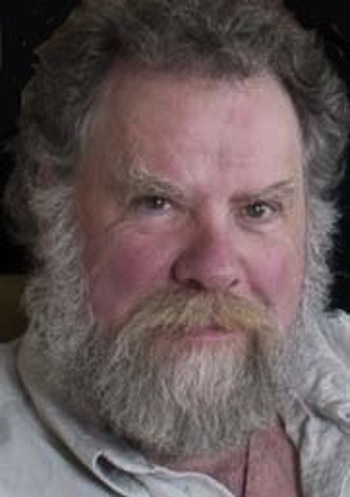Visual Arts Interview: George Fifield — Boston’s Cyberman
George Fifield, the bearded curator, scholar, and activist, has been pushing the conceptual ball called contemporary digital and intermedia art up a hill for decades.

George Fifield, Founding Director, Boston Cyberarts — “Animation, storytelling, dance, nature, every type of variety thrills me.”
By Debra Cash
Every night, at one a.m., George Fifield’s personal robot goes to work.
His off-the-shelf Roomba glides over the brick floor of the Boston Cyberarts Gallery inside the Green Street MBTA station in Jamaica Plain, as darkened video monitors on the wall wait for daylight to convey the history and experimentation of 20th and 21st century digital arts.
The Roomba is only one of a number of gadgets Fifield showed off on a recent snow day. For his birthday, his wife got him a Sphero an iPad activated ball with a startling resemblance to a hamster-activated run-about toy. It’s a newer generation of the classic remote-controlled plywood airplane: as it skitters across the floor, an augmented reality program can display different virtual characters on the screen and the game can be played alone or with friends.
The toy launches a metaphor. Now 64, the bearded curator, scholar, and activist has been pushing the conceptual ball called contemporary digital and intermedia art up a hill for decades. These days, happily, he can look around at his small gallery space and know that his efforts have found traction.
Since his days founding and running The Boston Cyberarts Festival, which presented seven festivals between 1999-2011 showcasing how new technologies could be incorporated into and transform traditional visual and performing arts, Fifield has been the perfect combination of playful experimenter and informed advocate. He has been a steady and strategic partner for arts that, well, not everyone has considered artistic.
Recently nominated by the Isabella Stewart Gardner Museum to a five-year term on the Board of the Boston Art Commission, his presence on that official body speaks to his persuasiveness.
The 2015 Boston Cyberarts Gallery show and lecture series on the legacy of MIT Center for Advanced Visual Studies (CAVS) professor and public artist Otto Piene and his Sky Art spectacles curated with Joseph Ketner II, and John Powell, which runs through February 15, is just one of his current projects. In front of the Boston Convention and Exhibition Center in South Boston, Art on the Marquee, a partnership with the Massachusetts Convention Center Authority, has displayed more than 100 original media works on an 80 foot tall LED marquee. (The newest pieces, grouped thematically under the broad theme of athletics, will be on view through mid-March.) Two 10 by 12 foot screens are part of the Boston Harbor Islands Welcome Center on the Rose Kennedy Greenway. Most recently, rocket scientist-turned-artist Mark Stock has repurposed algorithmic data streaming off the islands to generate abstract images of clouds, smoke, and waves. Fifield explains that he routinely finds himself making the case for computer code as an artistic discipline in and of itself.
“Animation, storytelling, dance, nature, every type of variety thrills me,” Fifield says. “The thrill is watching how artists will take the brand new technology and make it their own, explore it and sometimes even break it.
“One of my art heroes was Nam June Paik who took televisions and said ‘let me show you why this is art’ and proceeded to show everybody that was true. But what’s interesting is that digital art and video art [created around the same time] had two divergent paths in terms of acceptance. By the end of the 1970s, every serious museum was investing in video art, but nobody was showing computer art. People could understand photos and video and someone going out and shooting something, or taking a picture and manipulating it, but they didn’t understand [the creativity of digital artists’] code because they thought the computer was making it.”
It was video that got his foot in the door; at the DeCordova Museum and Sculpture Park in Lincoln, MA, Fifield started curating video art in 1993. Over the next dozen years, he was able to enlarge his portfolio and not incidentally make many of the DeCordova’s digital shows unique, “must see” events. Then-director Paul Master-Karnik, Fifield says, was especially supportive: “He knew new media was an experiment and experiments sometimes fail.”

Fifield launched the Boston Cyberarts Festival in 1998. As a point of reference to that technologically distant era, that was the year Apple released the gumdrop-shaped iMac. The festival, which was hosted across a range of indoor and outdoor venues and found spaces was certainly an expensive and complicated effort to produce, but Fifield says that eventually disbanding the festival was a deliberate choice about which he has no regrets. “The purpose of the festival was to make art institutions and the art-going public comfortable with new media.” he says. “By 2011, we could declare victory and go home.”
That victory may be sweet, but it’s hardly mainstream. The horizon for digital art and performance keeps receding. In what may be the aesthetic and conceptual analogy to Moore’s law, as computing keeps improving and the cost of creating sophisticated, technologically-informed art works continues to come down, there are always new possibilities to investigate.
“Right now, I’m working on a show about robotic art with Alexander Reben and Boxie, which is a tiny cardboard robot that speaks in a little plaintive voice. My joy is picking a concept and actually using it to learn about something I never knew about before.”
Debra Cash, a founding Senior Contributor to the Arts Fuse and Scholar in Residence at the 2015 Bates Dance Festival, has been named Executive Director of Boston Dance Alliance.
c 2015 Debra Cash
